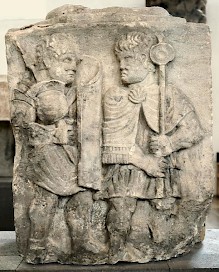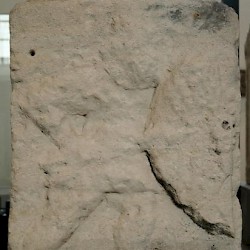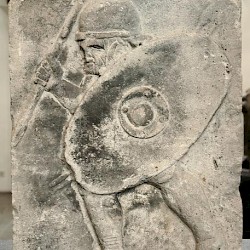Mainz, Kaestrich, Pedestals
Q571790Mogontiacum: Roman city, capital of Germania Superior, important military base, modern Mainz.

The Mainz Pedestals, which once supported several columns in front of the headquarters of the Roman fortress of Mainz-Kästrich and are now in the Landesmuseum, may not be what you have in mind when you think about classical art. And it is true, the human body has been rendered better by other sculptors: the heads, arms, and legs of the figures on these pedestals are not well-proportioned. However, this monument was certainly made by a great artist whose lack of anatomical knowledge is more than compensated for by something that, lacking a better expression, I call "power".
The pedestals belong to a building phase of the Kästrich fortress that is usually dated to the last quarter of the first century. After the Batavian Revolt, in which the city had been destroyed and the castra had only with difficulty withstood a siege, soldiers of I Adiutrix and XIV Gemina rebuilt the fortress. A decade later, in 83 to be precise, the Roman emperor Domitian visited Kästrich to conduct a successful war against the Chatti, which resulted in the conquest of land on the Rhine's east bank and the construction of the Taunus limes.
Representations of war
 Kaestrich, Pedestals: Griffin |
 Kaestrich, Pedestals: Fighting soldier |
 Kaestrich, Pedestals: Auxiliary soldier |
 Kaestrich, Pedestals: Advancing soldiers |

The monument may commemorate Domitian's Chattian war, or war in general. On one side, we see two heavily-armed legionaries march to the front (above), and we also see them in action. Maybe, the two men stand for the two legions. The spear fighter appears to be one of the light-armed auxiliary soldiers; the sword fighter is too damaged to be identified. It is odd to notice that no cavalry is represented.
Representations of peace
The other five slabs show the effects of peace: for example, two captives and the goddess of Victory. The central scene is a mourning woman, who represents Germania, weeping because of her loss of freedom. In a civil context, we would also have expected a representation of Peace, or the gods Mercury (trade), Ceres (agriculture), and Apollo (the arts). An example is the victory monument from Nijmegen.
But Kästrich was a military site, and the blessings of victory are shown in a different fashion: a soldier returning with a bag that must have contained some precious objects.
 Kaestrich, Pedestals: Griffin |
 Kaestrich, Pedestals: Looting soldier |
 Kaestrich, Pedestals: Germania capta |
 Kaestrich, Pedestals: POWs |
 Kaestrich, Pedestals: Victoria |